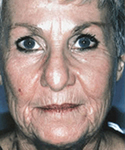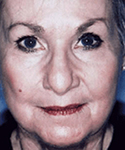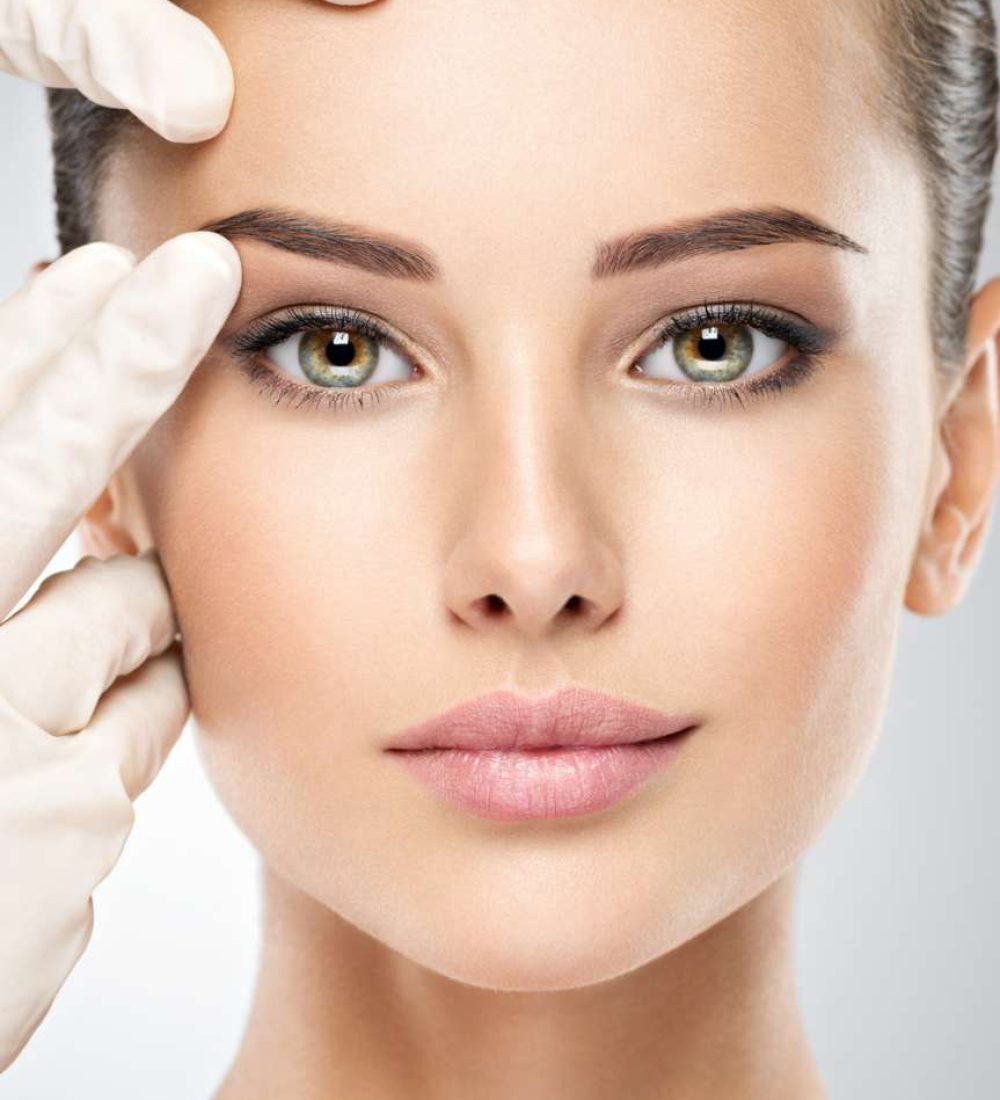Centrally located in Southampton, PA and serving Philadelphia, Bucks, and Montgomery Counties, The Kole Plastic Surgery Center performs facelifts for patients desiring plastic surgery.
A facelift, or rhytidectomy, is a surgical procedure to improve visible signs of aging in the face and neck. It will reshape the lower two-thirds of the face. It can tighten the skin and the underlying slack muscles to improve cheek, jowl, and neck contour. It is one of the most popular forms of facial plastic surgery. It’s most often performed on a patient over age 40 to rejuvenate the appearance.
It’s important to approach your procedure with a realistic attitude. A facelift acts to restore your original youthful appearance. It does not stop the aging process. It is recommended for people who do not smoke.


Three types of facelift procedures are in common use. Dr. Kole will recommend one of these after consulting with you about your goals for the operation.
The traditional cosmetic operation uses incisions that begin within the hairline at the temple, extend downward at the base of the ear, come around the tragus in front of the ear canal, extend around the earlobe behind the ear, and then conclude at the hairline behind the ears. These incisions are well concealed within the hair and natural folds of the skin. Dr. Kole uses the tragus incision which minimizes scars that are visible in front of the ear. Through these incisions, the skin is elevated; the tissues are repositioned and sculpted; fat is repositioned, and the muscles are tightened back into their youthful anatomical position. Sometimes facial implants are used to add extra volume and recreate the youthful contour of the face, especially if bone loss over the years has caused weakening of the bony foundation. When the skin is re-draped, excess skin is removed, resulting in a more youthful appearance.
This cosmetic procedure—also called a mini-facelift—repositions the skin, muscle, and soft tissues of the face that have been affected by gravity, the aging process, and loss of elastic and collagen fibers over the years. The major difference between a short-scar facelift and the traditional one is that a short-scar facelift uses a significantly smaller length of incisions. This incision uses the temple and tragus incision but stops at the earlobe. This results in eliminating the scar around the earlobe and behind the ear into the hairline. This procedure may be ideal for younger patients with early signs of aging, such as jowls or loss of volume in the cheeks, but who have not yet developed prominent wrinkles in the neck or “marionette lines” extending vertically from the corners of the mouth. Our professional, experienced plastic surgeons also perform skin tightening and facial rejuvenation procedures as well.
A mid-facelift cosmetic surgery repositions and rejuvenates the portion of the facial anatomy extending from the eyelid to the upper lip. This procedure addresses aging signs or imbalances in this area that are not readily corrected by other techniques. The mid-facelift is a new addition to the traditional one and is designed to elevate and reposition the cheek fat and restore the cheeks’ natural fullness, as well as to correct imbalances and loss of volume in the lower eyelids. This procedure produces an anti-aging effect due to the repositioning of the cheek fat. This mid-facelift will not address the jowls or the neck region.
Although facelifts may take years off your appearance, it is important to understand what can be achieved with a resulting natural look and what professional facelift procedures cannot do. It primarily affects the lower half of the face, tightening and elevating loose and lax musculature, as well as repositioning fat and elevating skin of the folds between the nose and the mouth, the marionette lines vertically from the corners of the mouth, the jaw, and the neck. A mid-facelift also lifts the cheeks and lower eyelids. No facelift procedure corrects the signs of aging in the upper face, such as crows’ feet or forehead wrinkles. It is for this reason that a facelift is often combined with other procedures from a doctor with experience—such as a forehead lift or Botox® cosmetic injections—for total facial rejuvenation.
It’s not possible to stop or reverse aging with cosmetic procedures. What can be done is to repair some of the damage to your appearance caused by the aging process.
The cost for a one varies depending on the extent of operation necessary to achieve optimum results.
The Kole Plastic Surgery Center accepts cash, check, and credit card (MasterCard®, Visa®, American Express®, Discover®) as acceptable forms of payment.
Financing is also available through CareCredit®, United Medical Credit and Advanced Care.


A lot can be done with non-surgical treatments for lines and wrinkles, but sometimes the effects of aging require more extensive techniques. Men and women who have folds, creases and other severe signs of aging benefit from surgery. Dr. Kole, a board certified plastic surgeon who serves men and women in Southampton, PA, Philadelphia County, Bucks County, Montgomery County and surrounding areas of Bucks County, PA, recommends facelifts in these cases. To learn more about how it may help you, contact us to schedule a consultation.

215-315-7655
Kole Plastic Surgery Center
We firmly believe that the internet should be available and accessible to anyone, and are committed to providing a website that is accessible to the widest possible audience, regardless of circumstance and ability.
To fulfill this, we aim to adhere as strictly as possible to the World Wide Web Consortium’s (W3C) Web Content Accessibility Guidelines 2.1 (WCAG 2.1) at the AA level. These guidelines explain how to make web content accessible to people with a wide array of disabilities. Complying with those guidelines helps us ensure that the website is accessible to all people: blind people, people with motor impairments, visual impairment, cognitive disabilities, and more.
This website utilizes various technologies that are meant to make it as accessible as possible at all times. We utilize an accessibility interface that allows persons with specific disabilities to adjust the website’s UI (user interface) and design it to their personal needs.
Additionally, the website utilizes an AI-based application that runs in the background and optimizes its accessibility level constantly. This application remediates the website’s HTML, adapts Its functionality and behavior for screen-readers used by the blind users, and for keyboard functions used by individuals with motor impairments.
If you’ve found a malfunction or have ideas for improvement, we’ll be happy to hear from you. You can reach out to the website’s operators by using the following email
Our website implements the ARIA attributes (Accessible Rich Internet Applications) technique, alongside various different behavioral changes, to ensure blind users visiting with screen-readers are able to read, comprehend, and enjoy the website’s functions. As soon as a user with a screen-reader enters your site, they immediately receive a prompt to enter the Screen-Reader Profile so they can browse and operate your site effectively. Here’s how our website covers some of the most important screen-reader requirements, alongside console screenshots of code examples:
Screen-reader optimization: we run a background process that learns the website’s components from top to bottom, to ensure ongoing compliance even when updating the website. In this process, we provide screen-readers with meaningful data using the ARIA set of attributes. For example, we provide accurate form labels; descriptions for actionable icons (social media icons, search icons, cart icons, etc.); validation guidance for form inputs; element roles such as buttons, menus, modal dialogues (popups), and others. Additionally, the background process scans all the website’s images and provides an accurate and meaningful image-object-recognition-based description as an ALT (alternate text) tag for images that are not described. It will also extract texts that are embedded within the image, using an OCR (optical character recognition) technology. To turn on screen-reader adjustments at any time, users need only to press the Alt+1 keyboard combination. Screen-reader users also get automatic announcements to turn the Screen-reader mode on as soon as they enter the website.
These adjustments are compatible with all popular screen readers, including JAWS and NVDA.
Keyboard navigation optimization: The background process also adjusts the website’s HTML, and adds various behaviors using JavaScript code to make the website operable by the keyboard. This includes the ability to navigate the website using the Tab and Shift+Tab keys, operate dropdowns with the arrow keys, close them with Esc, trigger buttons and links using the Enter key, navigate between radio and checkbox elements using the arrow keys, and fill them in with the Spacebar or Enter key.Additionally, keyboard users will find quick-navigation and content-skip menus, available at any time by clicking Alt+1, or as the first elements of the site while navigating with the keyboard. The background process also handles triggered popups by moving the keyboard focus towards them as soon as they appear, and not allow the focus drift outside it.
Users can also use shortcuts such as “M” (menus), “H” (headings), “F” (forms), “B” (buttons), and “G” (graphics) to jump to specific elements.
We aim to support the widest array of browsers and assistive technologies as possible, so our users can choose the best fitting tools for them, with as few limitations as possible. Therefore, we have worked very hard to be able to support all major systems that comprise over 95% of the user market share including Google Chrome, Mozilla Firefox, Apple Safari, Opera and Microsoft Edge, JAWS and NVDA (screen readers).
Despite our very best efforts to allow anybody to adjust the website to their needs. There may still be pages or sections that are not fully accessible, are in the process of becoming accessible, or are lacking an adequate technological solution to make them accessible. Still, we are continually improving our accessibility, adding, updating and improving its options and features, and developing and adopting new technologies. All this is meant to reach the optimal level of accessibility, following technological advancements. For any assistance, please reach out to
mini facelift philadelphia, facelift yardley, best facelift philadelphia, facelift doylestown, facelift philadelphia